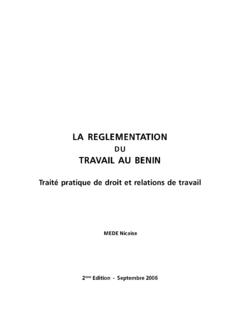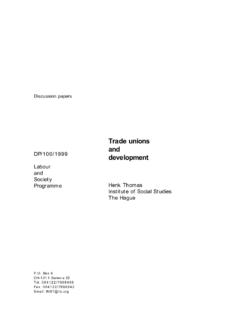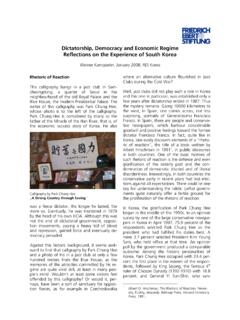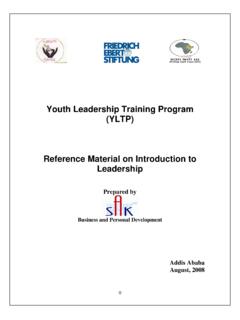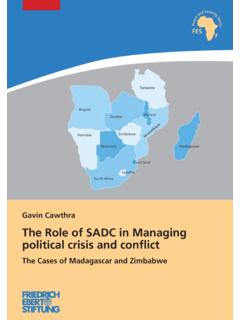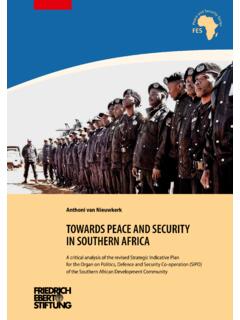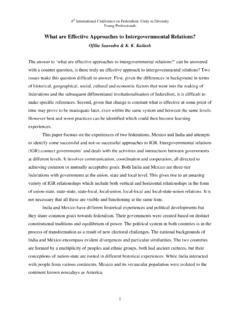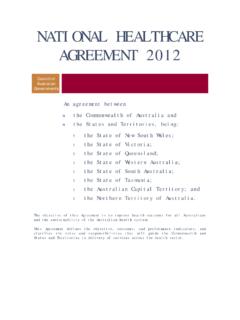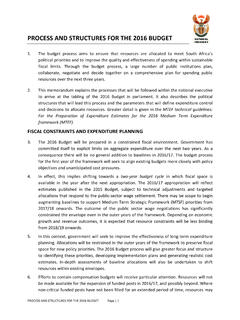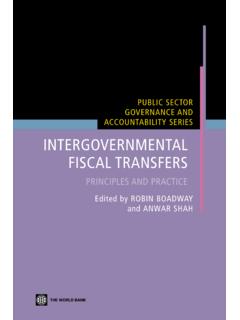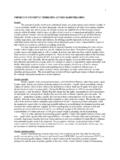Transcription of Public Finance Management Act, 2012: Review
1 intergovernmental relations Act 2012 : Reflection and Proposals on Principles, Opportunities and Gaps Winnie V. Mitullah University of Nairobi Institute for Development Studies Public Finance Management Act, 2012 : Review John Nguri CDC Consulting Group Ltd December 2012 . FES Kenya Occassional Paper, No. 6. intergovernmental relations Act 2012 : Reflection and Proposals on Principles, Opportunities and Gaps Winnie V. Mitullah University of Nairobi Institute for Development Studies Public Finance Management Act, 2012 : Review John Nguri CDC Consulting Group Ltd December 2012 . FES Kenya Occassional Paper, No. 6. ISBN: 9966-957-09-x TABLE OF CONTENTS. Part A: intergovernmental relations Act 2012 : Reflection and Proposals on Principles, Opportunities and Gaps 1. 1. Overview 1. 2. Conceptualising intergovernmental relations 2. 3. Kenya Model of IGR 3. Objects, Principles and Purpose 4. National and county Government Coordinating Summit 4.
2 Council of County Governors 5. Transfer and delegation of powers, functions and competencies 5. Dispute Resolution 5. 4. Opportunities and Gaps in AGR Act 2012 . 6. Part B: Public Finance Management Act, 2012 : Review 10. 1. Introduction 10. 2. Specific Areas of Concern in the Current PFM Act 11. Interpretations (Section 2) 11. 3. Responsibility of the Senate Budget Committee (section 8) 12. 4. Responsibility of the CRA indicated in (Section 190) 12. 5. The National Treasury to enforce fiscal responsibility principles (section 15) 13. 6. The national Treasury to administer the consolidated fund (Section 17) 13. 7. The National Treasury to Administer the Equalisation fund (section 18) 13. 8. Advances from the contingent fund (section 21) 13. 9. Establishment of Parliamentary Fund and Other National Government Public funds (section 24) 13. 10. National Treasury to prepare annual budget statement (section 25) 14.
3 11. Budgeting process 14. 12. Loans and Grants Management 14. 13. General 15. FES Kenya Occassional Paper, No. 6. Part A: intergovernmental relations Act 2012 : Reflection and Proposals on Principles, Opportunities and Gaps Winnie V. Mitullah University of Nairobi Institute for Development Studies 1. Overview intergovernmental relation is an important principle in realising synergy among different levels of government and within specific levels for stability of entire government. It applies irrespective of the system of government embraced by a country since there is always the state and its related agency the government. For governments to work efficiently there has to be further decentralisation with lower levels of government taking central role in implementation of policies through various programmes. Although decentralisation, in particular its devolution aspect has been challenging to effectively realise, many countries have opted for some form of decentralisation aimed at ensuring efficient provision of services.
4 For many years Kenya embraced the deconcentration form of decentralisation which did not give full powers to local governments. Decision making was largely done at the centre with the Local Authorities (LAs) not having a free hand to formulate policies and laws relevant for managing their jurisdictions. Critiques of this model attributed the poor record of local development to the strong hand of central government, and advocated during the Constitution making for devolution of powers to the lower levels of government. This was achieved through the promulgation of the Kenya Constitution in August 2010. This, notwithstanding, more work remained to be done in terms of enacting relevant laws for full realisation of the devolution aspect of the Constitution. To achieve this, a Task Force was constituted to come up with a report, policy and propose relevant Acts of Parliament for operationalisation of devolution.
5 It is this process enabled by various government agencies and the Parliament that produced the intergovernmental relations (IGR). Act, 2012 . The IGR Act 2012 is Kenya's mechanisms for ensuring smooth operation between the two levels of government, National and County created by the Constitution of Kenya. Whereas there are many provisions in the Constitution that inform the IGR, Article 6 (2) is particularly crucial. The Article provides for two levels of governments at the national and county levels. The provision notes that the `governments are distinct and inter-dependent and shall conduct their mutual relations on the basis of consultation and cooperation'. These are not unique caveats to Kenya. They prevail in other jurisdictions which have embraced higher forms of decentralisation such as USA, South Africa and Nigeria. Apart from this introduction, this paper reviews the IGR Act of Kenya, 2012 by first providing a conceptual understanding of intergovernmental relations followed by presentation and discussion of the provisions of the IGR Act, 2012 , including opportunities and gaps.
6 2. Conceptualising intergovernmental relations IGR encompasses all the complex and interdependent relations among various spheres of government as well as the co-ordination of Public policies among different levels. The concept is commonly used to refer to relations between and within levels of government that facilitate 1 FES Kenya Occassional Paper, No. 6. the attainment of common goals through cooperation (Opeskin, 2001: 92,) and the interactions between the different levels of government within the state (Ademolekun, 2002: 60).These relations and interactions occur through policy alignment, reporting requirements, fiscal grants and transfers, the planning and budget and informal knowledge sharing and communication among officials (Fox & Meyer, 1995). The concept also refers to the fiscal and administration processes by which spheres of government share resources. The concept of cooperation is central in AGR.
7 Public service responsibilities are divided across governments, and each level has to operate within its jurisdiction taking into consideration the principles of cooperation and coordination. Cooperation should be geared towards sustainable development, the integrated delivery of services by inter-governmental system that ensures mutual consultation, coordinated strategic planning and accountability for performance and expenditure in terms of legislation. In adopting devolution, one anticipates a system that is dynamic whole but made up of various parts for efficiency and viability, each and every part must work coordinately otherwise the system collapses. No single level of government can deliver its mandate and vision of a nation on its own and hence the importance of cooperation and coordination which are pillars of effective IGR. It can therefore be argued that cooperative government cannot be achieved withoud developing appropriate intergovernmental forums at national and lower levels to deal with issues of alignment, integration and coherence.
8 Achieving this requires developing systems and processes with clarity on functions of each level of government, common objectives and protocols for engaging in joint work. This is because the levels of government have to interact both vertically and horizontally, with intra- governmental relations occurring when departments within the same level of government interact, with an ultimate goal of ensuring one vision of integrated government. Scholars, for example Layman (2003) in discussing the case of South Africa has observed that uncoordinated strategic planning and unilateral delivery of action by departments contribute to fragmented service delivery. Layman further notes that `the role of national government departments in service delivery must be made very clear, especially where the services create long term costs for lower levels. Wright (1988) and Bogdanor (1991) identifies essential features of IGR to include: all units of government, actions of officials and their attitude, regular interactions among Public elected and appointed officials, intergovernmental revenue and expenditure financial policy issues, borrowing and debt, policy formulation and implementation as well as distribution and regulatory policy content issues.
9 Wright (1988) further identifies three models of IGR, namely: coordinate or separated authority, inclusive authority and overlapping authority model. Kenya seems to have embraced the overlapping model with constitutional status. In this model the Constitution defines areas of autonomous actions by respective jurisdiction, and model power relations are also governed by the Constitution. Each level of government can defend its constitutional powers which make the powers limited and dispersed as argued by Wright. Wright concludes by noting that `in relation to authority patterns, the negotiation of the terms of exchange or agreement is interlocking, interdependent, balanced and bargaining'. This latter point brings out the spirit of Kenya Constitution highlighted in Article 6 (2) giving prominence to consultation and cooperation. Besides, the importance of the features of IGR, there are different approaches in understanding and realising IGR.
10 Lawson (2011) identifies four approaches to IGR, namely democratic, constitutional legal, financial, and normative operational. In many ordinary discussions these approaches are often muddled. It is therefore useful to have an understanding of each approach. The democratic approach stresses local government right to self determination to the extent of regarding lower FES Kenya Occassional Paper, No. 6 2. levels as independent institutions. Advocates of this approach do not support centralisation of authority, but are in favour of greater devolution to lower levels or subordinate authorities (Hattingh 1998: 11). Sometimes advocates of this approach are viewed as separatists since they stress the autonomous right of existence of every level of government in itself. Critiques of this approach, for example Roux et al (1997: 171) argue that pressing democratic principle at the expense of values contradicts the basis of participation within a total government hierarchy.
